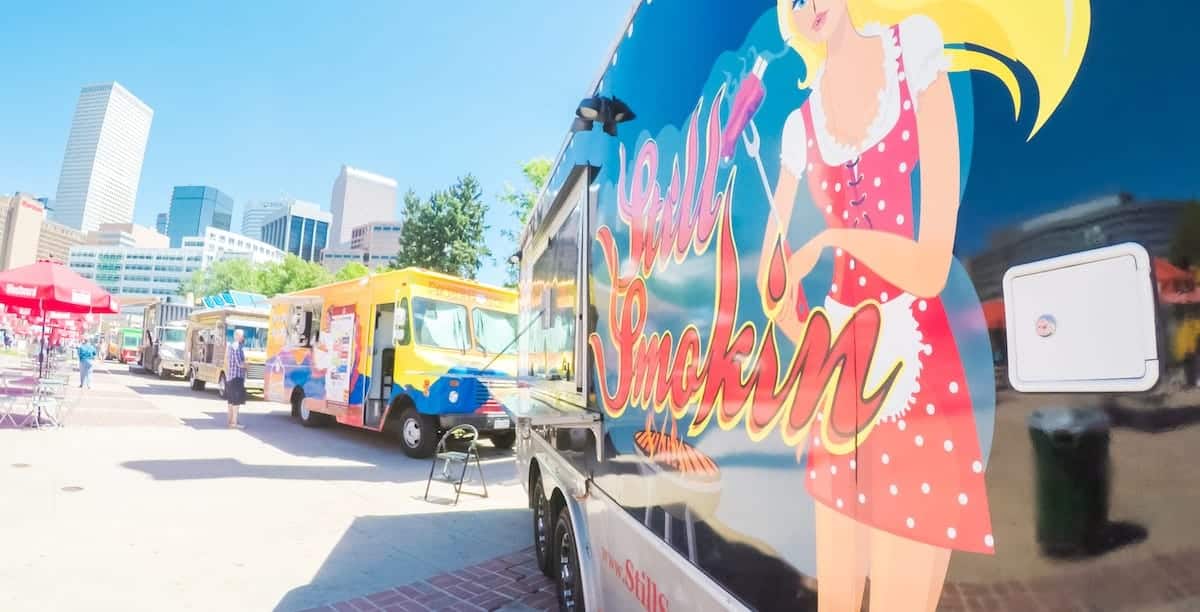Whether you’re grabbing a sushi-rito at a local event or watching Tyler Florence crush someone’s dreams, by now you’ve likely heard of a food truck.
It’s one of the most aptly named products: a truck that cooks and serves food, willing and able to drive anywhere it must to do so.
But it’s also a disruptive business model that mirrors entrepreneurs in Silicon Valley rather than cooks working the line at a restaurant.
And it’s an industry that’s growing like crazy. Already bringing in over $600 million a year in revenue, food trucks are expected to generate $2.7 billion in the coming years.
In the Denver Metro region, the number of food trucks has nearly tripled since 2014, and according to Food Truck Nation, the region is the second-best place in the country to open up a food truck.
In Denver South food lovers congregate at the weekly DTC Eats food truck rally, held every summer, to get a taste of mobile culinary bliss. Not to mention that some of the Denver area’s favorite food trucks are frequently found in the Denver South area.
Sure, we all have to eat, but we have lots of options for how we get our food. So why does the food truck model work so well? Here are some of the key aspects that keep this industry moving:
Affordable entry
While it can vary, buying a food truck is surprisingly not that expensive, especially compared to starting up other types of businesses within the food industry.
According to Foodtruckempire.com, a beginner’s food truck can be snapped up starting at $25,000. Want to get a decked-out truck with all the bells and whistles? You might hit $100,000.
Sure, it’s not like we all have that kind of money just lying around, but compare that to the cost of starting a restaurant, which averages nearly $300,000, more if you want to buy the building.
But, of course, you also have to pay for permitting, and that cost can swing depending on where you’re operating. However, on average, permitting costs just $100 to $500 for food trucks. If you want to open a full-fledged restaurant in Colorado, you’ll probably want a liquor license. Just applying for one will cost you nearly $3,000. We’re betting food truck permits are more affordable for most new business owners.
If you want to cook your own food on your terms, food trucks offer the lowest bar to entry, providing ownership at a fraction of the cost of most other businesses.
Mobility
Every CEO at every tech company in the country is hammering a “mobile-first” strategy to their employees.
Food trucks, by definition, are not only mobile-first, they’re mobile only. And this model fits remarkably well with the way people get their food in the modern world.
Some are looking for cheaper dining options that still offer high quality, while others are simply too busy to think about it and just want another option besides whichever fast-food restaurant is nearby. Park a food truck in the right spot, and the customers won’t stop coming.
But park it in the wrong spot, and … well, you just park somewhere else.
The proliferation of social media has also facilitated the food truck boom. Before Facebook, Twitter or Yelp, it would have been virtually impossible to tell hungry customers where you were going to be located for the day, or what the menu would be. It was the Dark Ages of the food-truck business.
Today, fans can find out where their favorite truck will be directly from the owners, and if the food is good enough, they’re even willing to follow it around. Owners don’t have to be tied to any one location at any given time, they can reach their audience when and where it’s most convenient.
It’s a lesson to every business in the modern economy: meet your customers where and when they need you, and you will be rewarded.
Suggested Reading:
Acting like a tech startup
While food trucks might seem unique to the food business, they tend to operate more like tech startups than other food businesses.
You may have heard the term “minimum viable product” (MVP) in reference to startups. This refers to the leanest possible way to launch a product that still works.
Food trucks are the ultimate MVPs. Some are literally run entirely by one person and require nothing more than a parking spot and a permit. That’s a lean model that most VCs in California would drool over.
Food truck owners also understand how to turn problems into opportunity. The food truck revolution began, in part, because of entrepreneurs that saw opportunity within failure and were able to solve a real problem for real people.
As Priceonomics reports, the Great Recession stalled many construction projects, which is where food trucks typically found their customers back then (like we said, it was the Dark Ages). This eventually inflated the inventory of used food trucks as many owners threw in the towel and sold them off for cheap.
At the same time, many chefs and restaurateurs had lost their jobs, and consumers were looking for ways to pinch pennies but not skimp on quality. Enter: food trucks.
It’s no fluke that the food truck business model has taken off and continues to grow across the country. When you break down what makes the model work, it starts to feel familiar: consumer-first, mobile-first, lean, flexible and opportunistic.
It’s all about food in this case, but the lessons of this industry can be applied to nearly any new business, and there’s much established, larger companies can learn as well.
And if all else fails, just have Tyler Florence come in and yell at you.
Related posts:
· Why craft beer works
· Perfecting an elevator pitch


